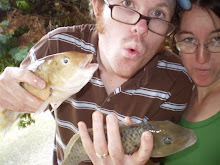The Kenyan Wildlife Service (KWS) manages the National Park and kindly transport us over to the island on their boat. Once on the island we divide up into several raiding parties, scale the jagged rock face and catch as many chicks as you can in 20 minutes so as not to disturb the nesting for too long. Once you have run out of bird bags you carefully climb down the rock to the beach below. Because the chicks are still growing, only their species and ring number were recorded before the chicks were returned to the area they came from. For the penultimate voyage we set up a couple of mist nets that yielded 13 adult Roseate Terns.
Last week was our final trip. There were only about 150 adults and 3 chicks left on the island. On the boat ride in we saw a African Fish Eagle perched on one of the ledges. There was plenty of evidence of its feasting at the nesting site. However, the Terns faired much better with the eagle than with the rats of last year.
Over our five trips we ringed 272 Roseate and 9 Sooty Tern chicks. It will be interesting to follow this generation of Tern chicks as they mature and finally return to breed in a few years time.
Our way back from a successful Whale Island expedition. See Whale Island behind me (and Stanley) in top photo
Crazy Bird Fact:
Sooty Terns are very unique when it comes to seabirds. They don't produce the oily substance that makes seabird’s feathers water resistance. If they were to land on the ocean, they would quickly soak up the water and sink. So instead, they just fly...and fly...and fly some more. The adults won't touch terra firma again until the come back to breed in a couple of years. The next time Sooty chicks we ringed will return to land, I will be well into my 30's. That's right, they will spend 6 to 7 years flying around - even sleeping as they fly! Amazing!
A very Sooty Tern.








No comments:
Post a Comment